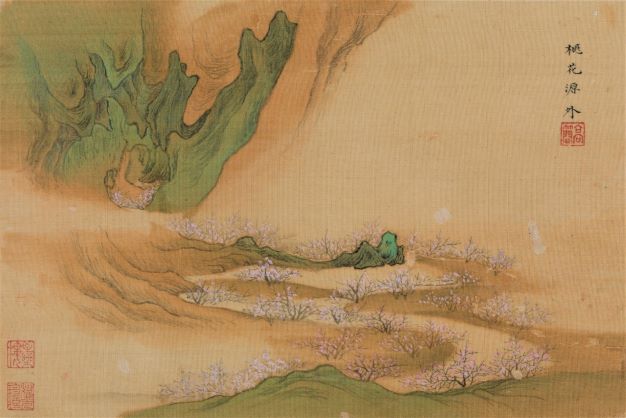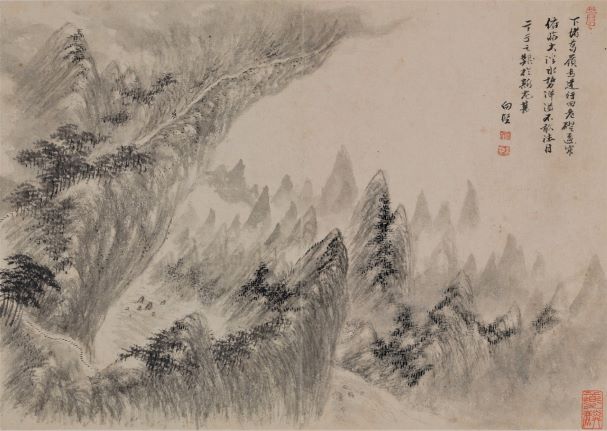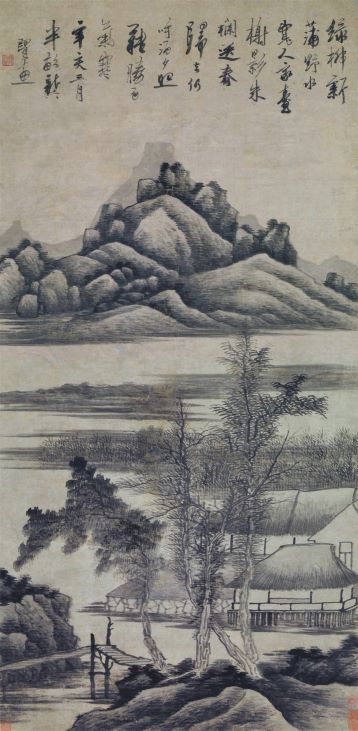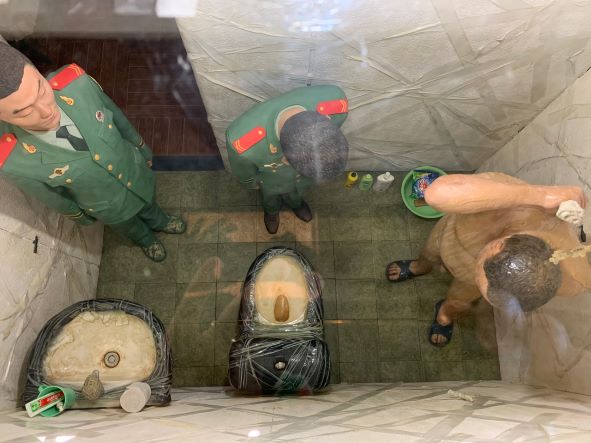藝評
When one’s future is an open wound
華立強 (Eric Otto WEAR)
at 4:53pm on 28th March 2022




A review by Eric Wear of two exhibitions in Europe focused on periods of change in China - the first, in Paris, of the transition between the (Han) Ming and the (Manchu) Qing. And, an examination of Ai Weiwei's recent exhibition in Lisbon.
Captions:
Image 1. GAO Jian (1635-1713) Album inspired by poems of Tao Yuanming (first page), undated © Hong Kong Museum of Art
Image 2. HUANG Xiangjian (1609-1673) Album Journey in search of my parents (third page), undated © Hong Kong Museum of Art
Image 3. GONG Xian (1619-1689) Young rushes and slender willows, 1671 © Hong Kong Museum of Art
Image 4. AI Weiwei (b 1957) View into one of the six boxes composing S.A.C.R.E.D., 2016. Photo by Eric Wear.
When one's future is an open wound
by Eric Wear
A society’s great tragedies not only extinguish a way of life, but crush the expectations of individuals. A generation may be left with the pained awareness that if there is a preferable future beyond the bleak present it is one in which they will not live, and in which perhaps they will not be remembered. Broken, angered, numbed, they may rail against the forces that bear down on them, or retreat into private preoccupations tinged with melancholy, nostalgia or escapism. Their subjectivity is expressed in an art of open wounds where the devastation of unseen events weighs heavy on the viewer.
The art of two recent exhibitions cannot be disentangled from ascendent oppression. The brutal seventeenth-century Manchu conquest of China is the background to the Cernuschi exhibition while the work of Ai Weiwei is inseparable from his persecution in and exile from the China of the CCP.
Modern Chinese education and historiography sanitises the Manchu invasion, treating the conquest – and that of neighbouring regions such as Xinjiang (‘new territories’) – as being not unlike other local changes in ‘Chinese’ dynasties. Such a notion of continuity would hardly have been the experience of Han artists and their patrons during the first decades of Qing rule. And it is the value of the Chih Lo Lou Collection that it focuses on Ming loyalists and other disaffected artists of this period.
To set the scene, the Cernuschi exhibition began with paintings and calligraphy by major figures of the mid to late Ming, including SHEN Zhou, WEN Zhengming and DONG Qichong. With robust brushwork, formal balance and a rhetoric of grandeur, these ranged from the expansive calm of layered greys in TANG Yin to the opulence of LAN Ying’s suite of large hanging scrolls on gold leaf paper. While the latter inclines to empty luxury, it evinces the resources available in the cultural landscape of the late sixteenth and early seventeenth century. But the present viewer sees this moment through the lens of later events, as a prelude to a tragedy unknown to those living at the time.
The Manchu conquest that began in 1644 was a slow-moving event, with the violent pacification of the Han requiring several decades and resulting in widespread economic ruin. The first responses were those of bitter resistance, as reflected in a handscroll by the scholar official HUANG Daozhou where a staccato rhythm of roughly torn pines and unbalanced stones is accompanied by an agitated inscription. (Huang was captured and decapitated soon afterwards.)
As the occupying forces gradually consolidated their hold on the Han heartland in the years that followed, artists worked with reduced patronage in a fallen state. The resulting art is smaller in scale, and often focused on a nostalgia for vanished cultural values, as in GAO Jian’s album referencing the unrecoverable paradise of Peach Blossom Spring. Palm-size, this is a work of pained intimacy with minuscule inscriptions in a slightly mannered hand. An album by HUANG Xianjiang carries the haunting title ‘A voyage in search of my parents’ and shows a procession of tiny figures wandering across pages of hostile landscape. Elsewhere XIAO Yunchong turned his eyes from the present, picturing a fantastic landscape of archaic and distorted forms, rendered in soft, whimsical colours. Other artists -- in some cases with familial relations to the deposed Ming monarchs -- invented themselves as marginal, anarchic characters, taking up socially protected but powerless roles as monks. As though holding the world in light disregard, the jagged or flippant brushwork and unconventional compositions of SHITAO and BADA Shanren may have been ironic comfort to viewers with whom the artists shared a sense of being deprived of substantial agency and meaningful careers.
The consolidation of Manchu rule also found its eventual collaborators in artists such as WANG Hui who tailored his lush and breezy landscapes to the new regime and led teams of artists to produce large-scale descriptive works chronicling the travels and rituals of the new imperial court. A later generation of Han artists would regain a position of specialised respect within the Qing realm, but would cautiously emphasize historicism, enriching their art through the archaeological study of ancient inscriptions. In this exhibition WANG Yuanqi foreshadows this with highly referential painting made within the gilded cage of his curatorship of the Imperial collection that the Qing rulers had seized from the Ming.
The Cernuschi exhibition ended with hanging scrolls by DAI Benxiao and GONG Xian. While DAI’s convoluted landscape suggests the unease of a cul-de-sac, GONG’s was made for mourning. His landscape is saturated in dark and wet grey washes; a mass of mountains weighs down on a vacant and abandoned villa set in a black and swampy foreground.
The range of responses to the Manchu conquest can be compared with the decades of CCP rule. Controlled and censored, cultural producers have often served the Party, or else retreated into nostalgia, formal explorations and academicism supported by the development of a market in which critical positions are strictly circumscribed. AI Weiwei has stood out as an exception, a sometimes artist, theorist and slyly non-conforming hooligan. In ‘Rapture’ it was also apparent that his art reflects the calamitous consequences of this resistance.
‘Rapture’ was presented in Lisbon as a mini retrospective, introducing Portuguese to the work of AI who has now set up a home in this country. The arc of his career has led him from being a contradictory character within art circles into a larger role as a social critic and eventually a dissident. Working across many media and often with collaborators for the production, AI’s metaphors have matured, taking forms that are seemingly serendipitous, occurring adventurously, sometimes unplanned. And they have often involved not only his personal experience but also his body. He is physically imposing, and this matters. When he assaults a policeman who is following him with a camera, the policeman pulls back, yields his camera; it is a street fight. And this is documented on film and presented as something akin to a performance. Calling attention to the increasing scope and depth of authoritarian rule by the CCP is a strand that runs through AI’s decades of work. Moving from local critiques of the abuse of authority, he has increasingly addressed generalisations of power and larger-scale mendacity such as the cover-ups of faulty construction of schools that led to a greater death toll of children during the 2008 Sichuan earthquake.
In an effort to silence him AI was taken into custody by the authorities and held incommunicado at an undisclosed location for 81 days in 2011. S.A.C.R.E.D. (2016), was made in response to this captivity and was a prominent part of the Lisbon exhibition. Six steel boxes resembling shipping containers contained life-size dioramas depicting AI undergoing routine moments during days of imprisonment. An exercise aimed at ‘breaking’ the subject, this involved strict bodily control under constant guard in an atmosphere of psychological uncertainty punctuated by interrogation or rote activity. External contact was forbidden. AI takes us to into this through flat literalism, each box brightly and evenly lit to supress any specific impression of time or place. The finish of the figures and settings resembles that of a natural history museum, or a forensic inquiry undertaken by technicians, and this substantially enhances the dehumanisation. Most striking are the small and irregularly placed openings in the boxes; peering through these – our only access to the scenes -- the viewer is made to occupy the voyeuristic points of view of external authority.
His writings banned and his life scrubbed from the Chinese internet, AI has been in exile in Europe since 2015. While outwardly comfortable and readily commanding media attention, this exile has come with a loss of precision. He has to go and seek the frontline, his body is no longer the site of a conflict with an oppressive apparatus. The resulting art is somewhat more abstract or scripted. This is apparent in large-scale works in several media that call out the cold indifference that has often greeted refugees in Europe. While the humanitarian intentions are unambiguous, the works lack the sharp and apt metaphors he achieved in a Chinese setting. While the connections may yet come, his career will likely continue as an unhealed wound, lived in response to what has been withheld.
Two exhibitions:
Painting Apart from the World: Monks and Scholars of the Ming and Qing Dynasties: The Chih Lo Lou Collection (on loan from the Hong Kong Museum of Art)
Cernuschi Museum, Paris
5 November 2021 to 6 March 2022
Rapture (the art of Ai Weiwei)
Cordoaria Nacional, Lisbon
4 June 2021 to 28 November 2021
